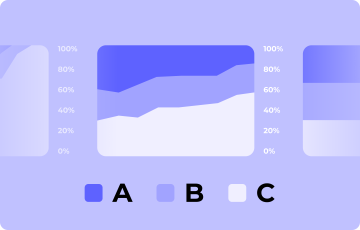
How to perform mobile app A/B testing to boost conversions in 2025
The average US adult uses 30 mobile apps each month, at roughly 10-12 apps per day. In 2024, mobile apps generated nearly one trillion dollars in revenue.
This presents an exciting opportunity for organizations and mobile app developers to attract users and grow their business. But things are not that straightforward.
There is fierce competition in attracting and retaining mobile app users. Between the Google Play and Apple App Stores, there are 4.83 million apps. Mobile users are spoilt for choice and will delete apps with bad user experience and glitches.
After doing the work of attracting users, keeping them becomes the key to business growth. The only way to keep your users is to continuously optimize their experience through A/B testing and experimentation.
By constantly testing and iterating, product and engineering teams can provide a better user experience and drive business growth.
In this article, we will walk you through:
- Mobile app A/B testing and how it works
- The benefits and limitations associated with mobile app testing
- Mobile app A/B testing examples
- The tools you need in your mobile app A/B testing stack
- Mobile A/B testing best practices

What is mobile app A/B testing?
Mobile app A/B testing is a form of mobile app experimentation (or mobile app testing) where you create a variation of a screen in your app by changing one element. This element can be your screen layout, design or features, performance, or how notifications are managed.
You test the original screen (the control) and the new screen (the variation) to find which performs better by dividing traffic between the control and variation. Then you analyze how your users reacted to each screen.
After analysis, you implement the screen that “won” to improve user experience, increase engagement, and drive revenue growth.
How mobile app A/B testing works
Mobile apps are built on different platforms with specific programming languages for each.
A mobile app built for the Android operating system (OS), for example, uses Java as the coding language. Apple’s OS (iOS) has a different, native language, Swift.
Because of how mobile apps are built, you need a software development kit (SDK) unique to the OS you’re working with. These SDKs enable you to run A/B tests and activate feature flags on your chosen mobile OS.
Your mobile A/B testing tool will offer different SDKs to enable you to run experiments and activate feature flags. Here is a handy process for how mobile app A/B testing works:
Identify and research issues
The first step in mobile app A/B testing is to identify issues in your app. For example, digging into your analytics may tell you that many customers are dropping off in your checkout flow. This obviously affects your revenue directly.
After you have identified an issue, you can further research it with a behavioral analytics tool like Heap and Mixpanel. These tools can help you pinpoint the areas of friction for your customers when they are checking out.
It could be that customers have trouble reading the text in your app. This may leave them frustrated as they may not see important information about shipping, adding to a cart, and continuing shopping.
Customer surveys and interviews are other ways you can research the issues you have identified.
Create and prioritize your hypotheses
Knowing the issues you have identified, you can create a hypothesis that aims to solve those issues.
Your hypothesis should propose a solution to the issues and predict results that you may see when you implement the hypothesis.
Your hypothesis may be:
“Making the text on the checkout screen will reduce frustration for customers and improve conversions.”
Another hypothesis can be:
“Making important information like shipping, continue shopping, and cart bolder on the checkout screen will increase conversions and reduce customer drop-off.”
Because you may have many hypotheses, it is worth prioritizing them. You can use the PIE framework to prioritize your hypotheses. The PIE framework stands for:
- Potential: How much improvement can be made on this page(s)?
- Importance: How valuable is the traffic to this page(s)?
- Ease: How difficult will it be to implement a test on this page or template?
You can assign a number 1-10 for each of these three areas to determine which hypothesis you want to test first.
Build and run your test
To build your test, you need a mobile app A/B testing tool like Kameleoon that offers a robust platform to test on mobile devices.
To build your A/B test in Kameleoon, log into the Kameleoon App. On the homepage, click on “New Experiment,” then select “In the code editor” experiment.
Choose the kind of experiment you want to run; SDK for mobile app A/B testing.
Kameleoon offers the following mobile SDKs:
- iOS SDK
- Android SDK
- Flutter SDK
- React Native SDK
Mobile app A/B testing takes place on the server side, so using developer resources is a necessity. Using the WYSIWYG editor is not recommended as it severely limits what you can test. The changes you make in the visual editor don’t always appear correctly compared to coding them directly.
Next, name your experiment.
Finally, head into the code editor to design your variation screens. After coding your variations, finalize your A/B test by attaching goals and audience targeting.
Analyze your results
Your experiment should run for at least 2 business cycles. This will help you counteract seasonality and other external factors.
After your experiment ends, analysis is the next step. During analysis, you look into the results of your mobile app experiment to see if your variation screen had a positive, negative, or neutral effect when compared to the original screen.
If your variation has a positive effect and beats your control, you can roll out the changes to your audience.
In Kameleoon, you can also roll out features to a small segment of your customers. This way you can monitor your customers’ reactions to the changes, and you can roll back features that are not a hit.
In the event that your variations lose to your control, it is an opportunity to learn and iterate on future tests.
Benefits of mobile app A/B testing
Like web testing, mobile app A/B testing has many benefits for product and engineering teams.
Validate product ideas and features
With mobile A/B testing, you can test feature and product ideas that are still in production to determine if they have value to your audience.
According to Lucia van den Brink, Founder of Increase-Conversion-Rate.com and Women-in-Experimentation.com, "without A/B testing you’ll be shipping changes blindly, which can be dangerous.”
By testing features in production, you validate them way before launch. Your users’ reaction and behavior to this proposed feature tell you if it’s worth further investment of time and resources. This saves you money and time in the long run.
Reduce risks associated with new features
When you A/B test features on your mobile app, your users' reactions to these features help you determine if a new feature is worth incorporating and releasing to every user. This way, you don’t release features that users do not need or want.
Using feature flags, you can further reduce any risk by seeing how a small segment of your audience reacts to the new features outside of a test. This takes the guesswork out of planned feature releases.
Boost user engagement and retention
When you A/B test on your mobile app, you are actively optimizing experiences and improving your overall app for your users. This goes a long way toward boosting user engagement and retention.
When users encounter an area of frustration like an unclear checkout flow or slow loading times, they tend to leave the app. This reduces how often they engage with your application. But when this issue continues with no fix, your users will look for alternative apps, increasing your churn.
By A/B testing your app, you stay on top of improving features and eliminating areas of frustration for your users. This keeps them using your app for years to come.
Limitations of mobile app A/B testing
Mobile app A/B testing is resource intensive; you need developers to code your tests and time to run them.
“App testing is much more complicated than experimenting on the web,” Lucia van den Brink continues. “First of all, the code has to be written by Android or iOS devs, secondly the change has to be released to the app store and downloaded by the user which makes the experimentation program slow.”
Unlike A/B testing on the web, mobile experimentation involves several members of your team working on getting the experimentation coded for its native mobile platform. Users who are bucketed in the test need to download it from the App Store for things to continue.
This can slow down the experimentation pace considerably.
Another limitation is that quality assurance testing of your test will draw on developer resources. This can make it hard for your CRO manager to preview experiments and launch themselves without the help of a developer.
Mobile app A/B testing examples
There are many areas where your product, engineering, and optimization teams can A/B test in your mobile app to increase engagement, customer retention, and revenue:
Push notifications
Notifications are one of the ways your customers are prompted to engage with your app—but other apps are also vying for attention with notifications.
Your users can quickly become overwhelmed and opt out of notifications. This reduces your overall user engagement.
A/B testing how often you send push and other notifications from your app to your users can lead to better engagement; notifications should always be timely and beneficial. Knowing that your app only sends necessary notifications can boost your user engagement.
Meetic, a French dating app, used Kameleoon to test its push notification system. Meetic noticed that some of its users opted out of push notifications which decreased user engagement.
By testing their push notification system, contextualizing it for their users, and reassessing how often they sent notifications, Meetic increased user engagement by 3% in the user segment that opted out of notifications.
Performance
Another area your team can test is performance. Optimizing your app performance can go a long way toward increasing users engagement and retention.
If your app is available in multiple countries, the performance of your app will differ as users in countries with less developed data infrastructure may find your app takes too long to load screens.
Facebook offers a lite version of all their apps to improve experiences for users who live in places with slower internet connections.
While maintaining two apps is a lot of work, you can still optimize your app performance. Optimizing the performance of your app to load fast and work with the available internet connection of all your users, regardless of location, goes a long way in increasing user retention.
Checkout Flow
Your checkout flow directly affects your revenue. The number of customers who make it to this screen but do not convert can affect your bottom line.
There are so many things you can optimize in your checkout process to reduce the number of customers who drop off. You can A/B test:
- Placement of your free shipping notice to increase the attention of customers who will meet the threshold.
- Free shipping thresholds to see which amount drives more revenue.
- CTAs that contain relevant offers that customers may not be aware of.
- Product recommendations of upsells and cross-sells to boost the purchase of other products in your catalog.
Like Hello Bank, you can A/B test the first screen customers see in your checkout flow to increase the number of customers who make it to the end.
Through optimizing the first step in their account creation process, Hello Bank increased account creation by 23%.
How to build a stack of mobile app A/B testing tools
An experimentation tool is necessary for mobile app A/B testing, but it is not the only software that should be in your testing tool stack.
To build a proper stack of mobile app A/B testing tools, you need:
- A customer data platform (CDP) to handle visitor data whilst respecting their privacy
- A data warehouse (DWH) to store information for further analysis
- An analytics software for digging into the results of your experiment for insights that grow your business.
- Behavior analytics software for mobile apps to get customer point of view and understand your customers better.
- An A/B testing and experimentation platform where you can create, launch, and analyze tests on your mobile app, including feature flag management capabilities.
When choosing tools to build your mobile A/B testing, ensure that the different software integrates with each other and other tools in your marketing stack. A great example of a mobile A/B testing tool stack includes:
- Kameleoon as your feature experimentation platform that can help you update in near real-time with variables, test feature updates on a segment of your users, and experiment and personalize your mobile app to increase retention, engagement, and revenue.
- Tealium as your customer data platform
- Heap as your behavior analytics software
- Google Analytics as your analytics software
- Big Query as your data warehouse.
Kameleoon integrates with all the other tools in this stack, enabling them to share data with each other without bringing in additional tools. Other Kameleoon integrations include Mixpanel, Amplitude, Segment, Mapp, and mParticle.
Best practices for A/B testing mobile applications
When you get started with A/B testing your mobile apps, there are a few practices to keep in mind.
- Identify areas of your app ripe for testing. To identify these, it's important to analyze user behavior and feedback. Look for areas of the app where users may be experiencing issues, or where they are not engaging as much as you would like. These areas may be good candidates for A/B testing.
- Set clear goals and hypotheses. This helps ensure that the test is focused and that you have a clear idea of what you are trying to achieve. By setting clear goals and hypotheses, you can also ensure that you are able to draw meaningful insights from the test results.
- Choose the right metrics. Before conducting an A/B test, it's important to identify the metrics that are most important to your app's success. This could include user engagement, retention, conversion rates, or revenue. By choosing the right metrics, you can ensure that your A/B test results are relevant and actionable.
- Test one variable at a time. To get accurate results from an A/B test, it's important to test one variable at a time. This could include variations in design, layout, or features. Testing one variable at a time allows you to identify which specific change is responsible for any differences in user behavior.
- Use statistical significance to evaluate results. When evaluating the results of an A/B test, it's important to use statistical significance to determine whether any differences in user behavior are statistically significant. This helps ensure that any observed differences are not due to chance.
- Continuously monitor and analyze results. A/B testing is an ongoing process, and it's important to continuously monitor and analyze results. This helps ensure that your app is always optimized for the best possible user experience and performance.
- Use feature experimentation and feature flags to speed up the process. Collin Crowell points out that you can think of your app “like a car that’s already passed inspection. Once it’s approved to hit the road, you can adjust things like the music, seat settings, or A/C—without needing another inspection. That’s what feature flags do for apps.” This allows you to get your features approved in advance and make changes without waiting for lengthy reviews.
Getting started with mobile app A/B testing
When testing different areas of your app and analyzing user behavior, you need a partner A/B testing and experimentation solution to enable your mobile app A/B testing program.
Kameleoon is a Feature Experimentation solution that can help you test and iterate on your app improvement, ensuring that it meets your users' ever-changing needs and preferences.
Want to learn more about how mobile testing could benefit your team's experimentation?



